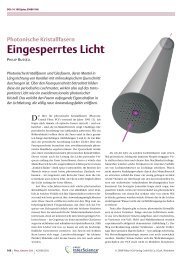Diploma thesis
Diploma thesis
Diploma thesis
Create successful ePaper yourself
Turn your PDF publications into a flip-book with our unique Google optimized e-Paper software.
Figure 3.3: Parametric down conversion, energy conservation and momentum<br />
conservation<br />
Ê (−)<br />
� � †<br />
(+)<br />
µ (�r, t) = Ê µ (�r, t)<br />
(3.10)<br />
Analogous to SFG, the χ (2) -tensor element describes the coupling between different<br />
polarizations involved. Yet, the process is reversed. The polarizations on the<br />
left hand side of equation 3.5 are created by the incoming pump field carrying the<br />
identical polarization. The fields on the right hand side describe the polarizations<br />
of the emitted signal and idler fields [17]. Orthogonally polarized signal and idler<br />
fields are called type-II PDC, identically polarized downconverted fields are named<br />
type-I PDC.<br />
To describe the process of PDC in detail, we have to compute the time evolution of<br />
an input state under the exposure of the Hamiltonian in Equation 3.8. The evolution<br />
of a quantum state can be calculated with the Schrödinger equation.<br />
� � t 1<br />
|ψ (�r, t)〉 = exp dt<br />
i�<br />
′ �<br />
H(�r, ˆ ′<br />
t ) |ψ (�r, t0)〉 (3.11)<br />
0<br />
In order to solve this equation, we expand the exponential function into a Taylor<br />
series:<br />
|ψ (�r, t)〉 =<br />
�<br />
1 + 1<br />
� t<br />
dt<br />
i� 0<br />
′ �<br />
H(�r, ˆ ′<br />
t ) + · · · |ψ (�r, t0)〉 . (3.12)<br />
Terms of order two and higher, are responsible for the creation of multiple photon<br />
pairs, procreated by the annihilation of multiple pump photons (âpâpâ † sâ †<br />
i ↠s⠆<br />
i ). The<br />
PDC interaction is weak, therefore the creation of multiple photon pairs is negligible,<br />
in the scope of this <strong>thesis</strong>. Consequently, we are only focusing on the creation of<br />
one photon pair by the destruction of one incoming pump photon. We assume no<br />
pump depletion and treat the strong pump field as a coherent wave with a Gaussian<br />
frequency distribution αp(ω):<br />
� ∞<br />
Ep (�r, t) =<br />
0<br />
dωαp(ω)e −i(� kp(ω)�r−ωt) + c.c. (3.13)<br />
.We assume a pulsed laser system that creates Gaussian pulses in the frequency<br />
domain, with a given pump central frequency ωp and a pump width σ, according to<br />
8



